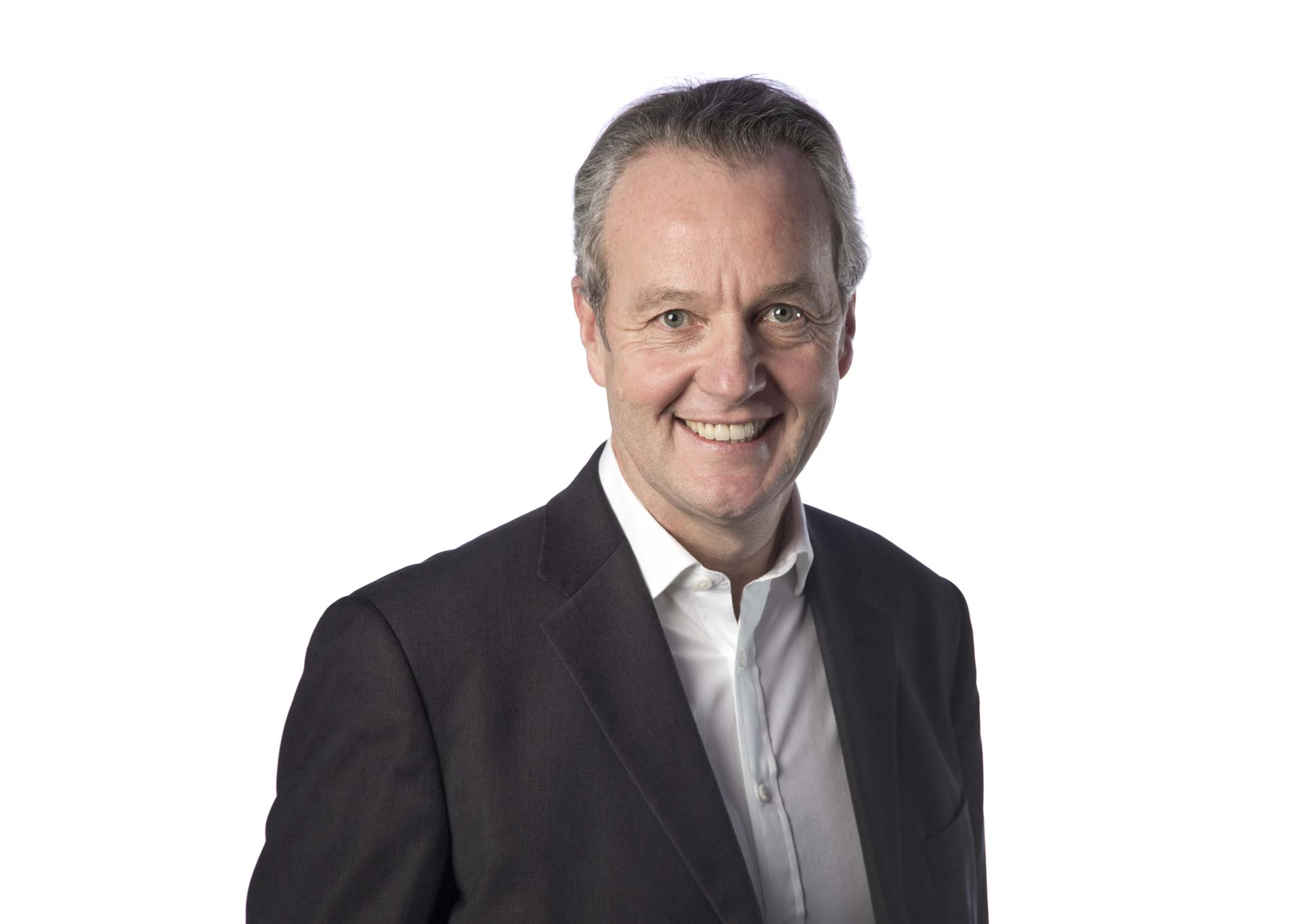Our Winter Wonderland: Christmas Traditions from our Partners
Our global network now covers 18 countries and this year we asked some of our partners to share their Christmas traditions at home.
Christmas Traditions across Africa
By Leon Staphorst
Most countries in Africa celebrate Christmas, like the UK, on 25 December. In most of these countries, such as South Africa, extended celebrations on 24 and 26 December also frequently form part of the festivities.
In some countries, celebrations can extend over a long period of time, such as in Ghana where it starts at the beginning of December and is focussed on Christmas and the end of the cocoa harvest season.
There are, however, a few countries that celebrate Christmas on 7 January. For example, in Egypt and Ethiopia this is the tradition of the Coptic Christians who still follow the older Julian calendar. Christmas in these countries is typically preceded by a 40-day fast, culminating in a Christmas Eve feast called the 'Glorious Birth Feast' on 6 January.
Interesting Christmas festivals throughout Africa include Gambia’s annual celebration of light, music and community during Christmas, creating giant, brightly lit and coloured floats of bamboo and paper called ‘fanals’ (lighthouses). The importance of women in the community, particularly midwives, are celebrated by the Ga people of Ghana. These celebrations are based on the local legend of the midwife Anna, whom many believe helped deliver the baby Jesus.
While there is no Santa Claus or Father Christmas in Liberia, children believe in the legend of the Old Man Bayka who parades the streets on Christmas Eve telling tales that berate the wealthy who do not give to the poor.
While Christmas in Africa also commemorates the birth of Christ in Bethlehem, the historic significance of Christianity migrating into Egypt during the 1st century AD, intermingling with Egyptian beliefs, also plays a role in many African countries. Christmas can also symbolise the birth of the African god Ra, the creator of ancient Egypt. People in these countries decorate trees to commemorate ancient times when Ra’s birthday was celebrated in this way.

Children playing Zambian nativity games

Old Man Bayka in Liberia
How does your family celebrate?
My family’s Christmas traditions include the gathering of my extended family at one of our homes. The small children will typically all sleep in tents pitched in the backyard. We attend church on Christmas Eve after having a Braai, an outdoor barbeque common in South Africa. The meats and fish are usually accompanied by side dishes ranging from home baked breads and roasted vegetables, to potato salad and pap, which is a kind of South African porridge made from maize meal, usually served with chakalaka, which is a spicy South African vegetable relish.
The children receive their gifts during this meal. On Christmas Day we have a family lunch consisting of cold meats and side dishes, as South Africa gets pretty hot during this time. In the evening we usually visit one of the light festivals in the area, such as the Lawley Street Lights or Jacaranda Children’s Home Light Festival in Pretoria.

A South African barbeque known as a 'Braai'
What food is eaten in other African countries?
In Kenya, Christmas feasts typically consist of grilled meat, called Nyama Choma, and potato stew, while Tanzanians like to roast a cow or goat for their entire their local village, washing it down with home-brewed beer. Liberian prefers beef, rice and biscuits for their Christmas feast and in Nigeria flavoured rice, tomato stew and fried chicken or goat are popular. In Ghana, locals enjoy Jollof rice, fufu and okra soup as their Christmas meal.
I wish you all a very merry Christmas, Leon.
Our Family Christmas in Slovakia
Martin Vavrek, Digital Transformation and Project Management


Tell us about Slovak traditions
Christmas is the main feast of the year in Slovakia. The first important date is Advent (a period of four Sundays and weeks before Christmas). This is when the Christmas season starts for most. The majority of Slovaks belong to the Roman Catholic church, and most Christmas traditions have a religious significance.
It is also a time for cleaning, baking, shopping for presents and decorating the Christmas tree. Christmas markets are organised in the bigger cities and the streets shine bright with dazzling lights. This period is the favourite part for my family. We meet our friends and colleagues to celebrate with cups of mulled wine or punch.
Slovaks also celebrate St. Nicholas’ day on 6 December, or as they call him, ‘Mikuláš’. It starts on the evening of 5 December and parents (playing Mikuláš) give presents to well-behaved children. They place their clean shoes near the door for Mikuláš to fill them with sweets and fruit.
How does your family celebrate?
For the last 10 years we’ve spent every Christmas in our weekend house in the small town of Brestovec because it has the perfect Christmas spirit. During the day on 24 December, we prepare the dinner and we also decorate the Christmas tree. The tree is kept up until 6 January, which is the Feast of the Three Kings—also called Epiphany. Religious traditions call on us to fast throughout Christmas Day. They say that if you manage to survive the day without a single bite, you will see a little golden pig in the evening.
It’s not Santa who brings the presents—it’s baby Jesus! A common tradition is that the children leave the room when baby Jesus arrives to deliver their presents. When the gifts are placed under the Christmas tree, someone rings the bell. That’s the moment when the children rush in.

Martin and his family at Christmas in Slovakia
What do you eat?
Our Christmas dinner consists of lots of courses including a fish dish, a potato salad and sauerkraut soup—kapustnica—with dried mushrooms and cream. Every family has its own secret recipe and some might include unusual ingredients such as dried plums or even apples. There are variations in every region in Slovakia.
Each family easily makes more than 10 different types of sweets which are served to their guests over the Christmas season.
Many people attend a Midnight Mass which is the busiest church service of the year. My family doesn’t attend this service, instead we pray in front of the Christmas tree after dinner.
25 and 26 December are much quieter. We cook lunch for our closest family. We rest and relax and overeat! 26 December is also when St. Stephen is celebrated and especially in the villages you can find many events and parties organised that night.
During the Christmas holiday we do lots of winter sports and long walks in the forest around our village. We also love sledding at this time of year.
From all of us here in Slovakia, Merry Christmas!
This article was kindly written by Martin’s wife, Martina. Thank you so much Martina.
Reindeer and Lots of Snow in Finland
Aki Uljas, Nordic Region, Subsea and Data Centres
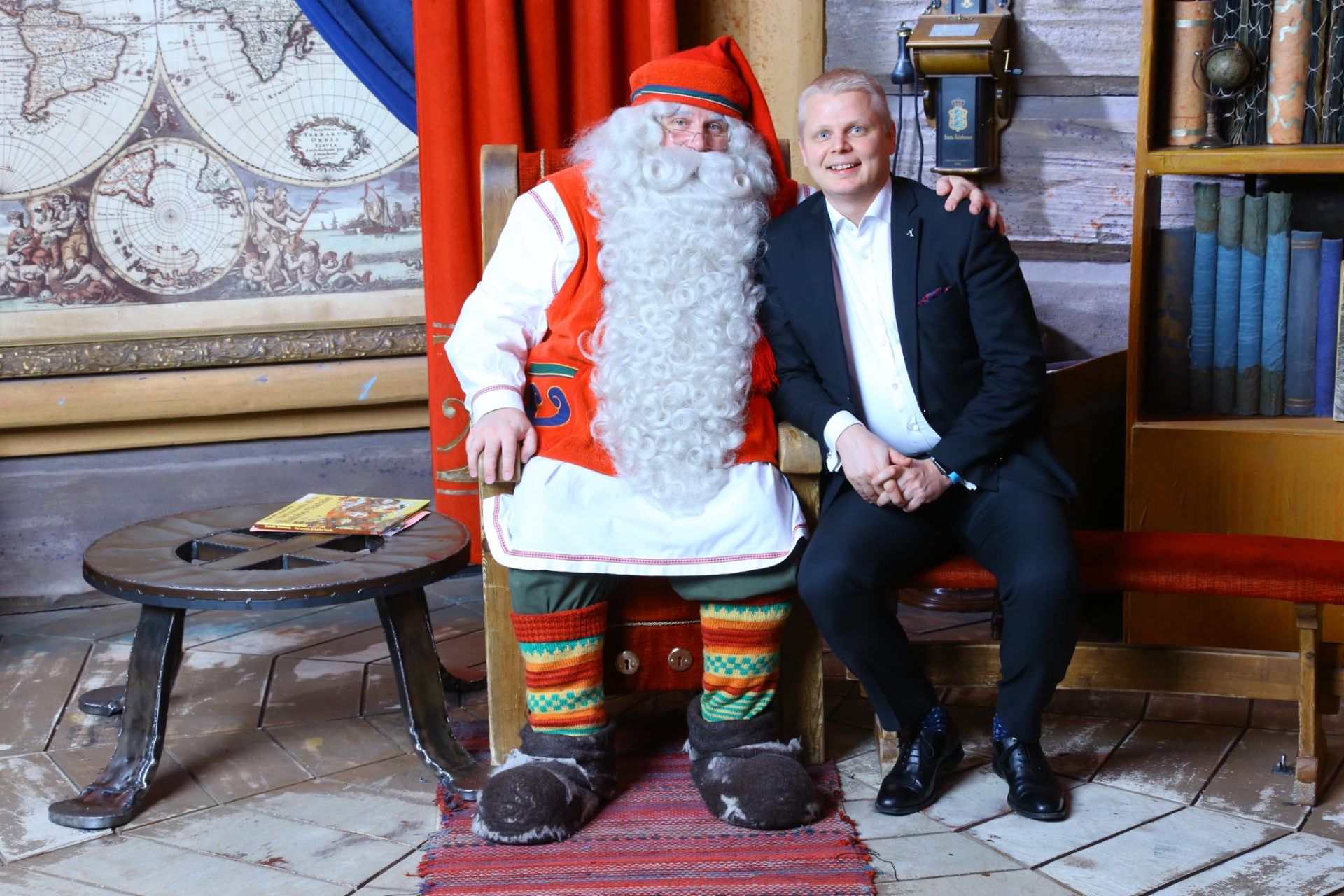
Finland is the home of Lapland and the mysterious factories where elves toil day and night to make gifts for the only delivery service quicker than Amazon Prime.
In Finland, Santa Claus is called 'Joulupukki'. This literally means 'Christmas Goat' and stems from folklore where a scary goat asked people for presents. Over time this goat learned some important lessons and became a giver of gifts—and also a human.
Joulupukki rides on reindeer and leaves gifts under the Christmas tree but if you have been naughty you might only get a bag of coal (which might actually be welcome during a fuel crisis).
The main celebration is in the evening on 24 December. This is the beginning of three holy days.
On 24 December, it is traditional to eat rice porridge and plum juice for breakfast. Often the tree is bought the same day, from a local market or square where you haggle over the price.
At noon, the 'Peace of Christmas' is broadcast on radio and TV by the City Mayor of Turku, in the south of Finland.
It is traditional for many families to visit the graves of family members once it has got dark (which is around 3pm this time of year). Some of the cemeteries are huge and require police to manage the traffic. Hanging lanterns often decorate the graves, creating a slightly macabre winter wonderland.
Many people also like to take a sauna on Christmas Eve.
The main feast is eaten in the early evening. Lutefish (salt fish) is the traditional starter. The main course is a leg of pork served with mashed potato traditionally baked in birch-bark boxes in the oven.
Most families make a casserole. Ham and cured salmon are also very popular.
Dessert is baked rice pudding served with spiced plum jam. One almond is hidden in the pudding. Whoever finds this almond will have good luck for the next year.
After the meal, Joulupukki might visit the house. When he comes in with his sack he asks if any children are living there. They tend to reply ‘yes’ vociferously while jumping up and down. Also, suspiciously, 100% answer 'yes' when they are asked if they have been good all year.
Christmas Day is much quieter with families usually spending it at home. On Boxing Day people like to go outside to walk and do sports. Skiing is popular or skating if the lake or river has frozen over.
Merry Christmas from the home of Santa Claus!!

The meaning of Hanukkah
By Jonathan Werth, Business Development
Hanukkah is an eight-day holiday that celebrates the rededication of the Holy Temple in Jerusalem. It starts on the 25th day of Kislev according to the Hebrew calendar, which falls between November and December. This year Hanukkah started on 18 December and will finish on 26 December.
The word ‘Hanukkah’ comes from a Hebrew word meaning ‘to dedicate or ‘to illuminate.’—it is often called the Festival of Lights.
The story behind Hanukkah goes back to 168 BCE when Judean Jews rebelled against Syria-Greek occupation and regained control of their temple. The temple was defiled by the Syrian soldiers who entered and desecrated its contents. A small group of Jews, led by Judah Maccabee, reclaimed the temple and restored it to religious use. They found only enough consecrated olive oil to light the menorah for one day, but miraculously, it lasted for eight days.
Relating to this story, the main tradition during Hanukkah is to light candles on each night of the holiday. Jewish families put up a special candelabrum called a menorah to commemorate the miracle of the oil. The candles are lit each night from left to right and from top to bottom, until all eight candles are lit on the eighth night. The last candle is called the ‘shamash’, or servant candle, because it is used to light all other candles.
Each night little gifts are given to children and the overall message is ‘little and often’.
Jewish families also eat foods that use oil to cook, like latkes (potato pancakes) and sufganiyot (jelly donuts). over this period.
Happy Hanukkah and Merry Christmas all, from London
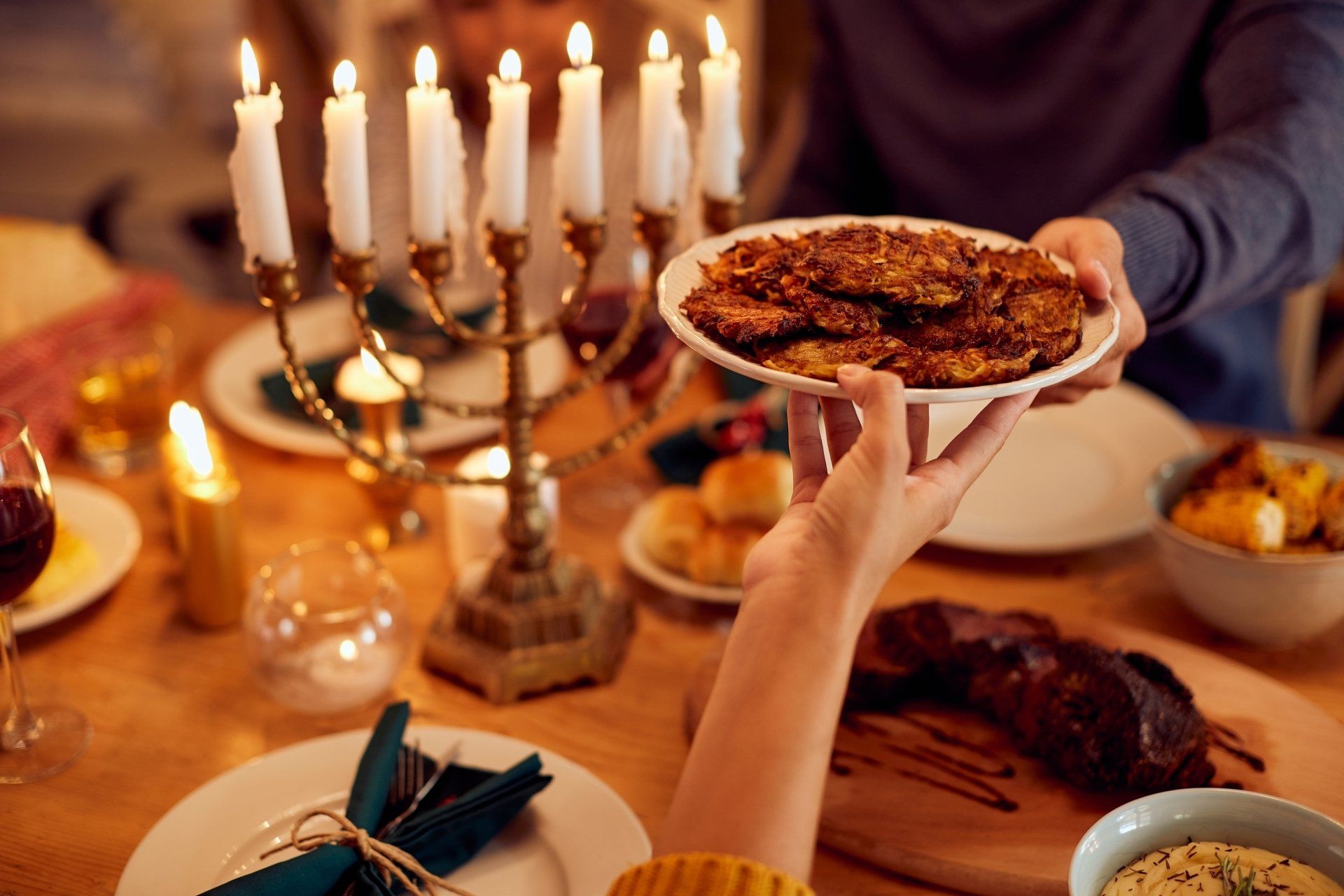
Christmas in the French Countryside
By Charles Orsel des Sagets, head of EMEA and LATAM
The French, as you may guess, celebrate Christmas with lots of good food and drink. The traditional Christmas meal includes turkey, roast beef, ham, goose, duck or chicken and game birds such as pheasant or quail, salmon and oysters. Roast chestnuts are also popular at this time of year.
In France, like many other European and Latin American countries, people celebrate Christmas and share gifts on the evening of 24 December.

How does your family celebrate?
My family goes to church for Christmas Mass, just before midnight, and then we have a Reveillon dinner at home. Reveillon is a long meal that happens on both Christmas Eve and New Year’s Eve.
Across Europe, Reveillon dinners still occur in France, Belgium, Portugal, Romania, Brazil, Quebec and New Orleans.
Either that same night or the next morning we open gifts which have been put under the Christmas tree. It is tradition that the Christmas tree must touch the ceiling of the room. We also put a Christmas tree by the front door called the ‘coronne de l’avent’.
Who usually does the cooking at Christmas?
Every year we have a family cooking contest when we get together in the countryside. We create teams of 3-4 persons and secretly prepare a full meal—lunch or dinner. At the end of the three days, we vote on the winner. This adds a lot of fun and motivates us to cook something very special and share out the tasks.
I wish you all a ‘joyeux Noel’ from the French countryside, near Paris.
Carp in the Bathtub—Czech Republic
By Denisa Pokrývková, Project Management

A selection of Christmas biscuits from the Czech Republic
Czechs and Slovaks celebrate Christmas in a very similar way, which is proof of our nations’ very close relationship throughout our mostly shared history. So I will leave out the parts about Baby Jesus, Christmas markets and Christmas trees, because those are exactly the same.
However, the typical Czech Christmas themes are a bit darker than the Slovakian ones, probably because unlike our Slovak brothers and sisters, us Czechs are not usually as religious.
This does not stop us from enjoying religious holidays like Christmas, in fact Czechs from all different backgrounds can be found singing Christmas carols or attending a Midnight Mass on 24 December.
Tell us about those delicious biscuits
Throughout the Advent period, people tend to get tense and frantic because of all the shopping and house-cleaning, but also because of the baking. It is customary to bake Christmas pastries, which are various kinds of bite-sized biscuits, all made by hand and usually decorated. It is the best way to get your home smelling festive and increase the stress-level just enough so you simply have to go to a Christmas market and try every single kind of mulled wine/punch/mead they sell. And let me tell you, there are a lot of variants when it comes to Czech mulled wine—some of them include absinth!
This definitely washes the stress away, which is what you need after you have been baking up to 13 different kinds of Christmas pastries, like my mum. As kids, we were not allowed to eat any of it before Christmas. But we were expected to help, only to see the delicious treats pile up in boxes on our balcony, because no fridge was big enough for them.
St Nick, an angel and the devil
Like many Christmas traditions everywhere, they are meant to scare children into listening to their parents and being good. For St. Nicolas day on 6 December, known as Mikuláš, family friends dress up as St. Nick and his faithful companions, the Devil and the Angel, and visit homes, preschools and elementary schools.
At home, children hang stockings on the windows in the evening and then in the morning they are magically filled with chocolates, sweets and fruit if they were good the whole year. If they were bad, they get coal in their stockings, and no sweets.
But on the night when St. Nick pays them a visit, the children who were bad get a chance to redeem themselves, either by singing a song or by reciting a poem. If St. Nick is sufficiently appeased by their performance, the Angel gives the children sweets and a friendly warning for the next year. If he is not pleased, he beckons the Devil to take the children straight to hell, in chains, wrapped in a big bag. You can imagine the screaming and crying involved.
What do you eat?
The festive period is crowned by the Christmas dinner. The traditional Czech Christmas dinner is a two course meal. There is soup followed by a breaded, fried carp with a potato salad. Each family has their own version of the salad, some make it with just cooked and sliced root vegetables and potatoes, diced onion, gherkins and hard boiled eggs. Some add peas, or kidney beans, and mix it all with mayo or tartar sauce (or both); even with a bit of mustard. It is a heavy side dish, but one everyone looks forward to since we only get to eat it once a year.
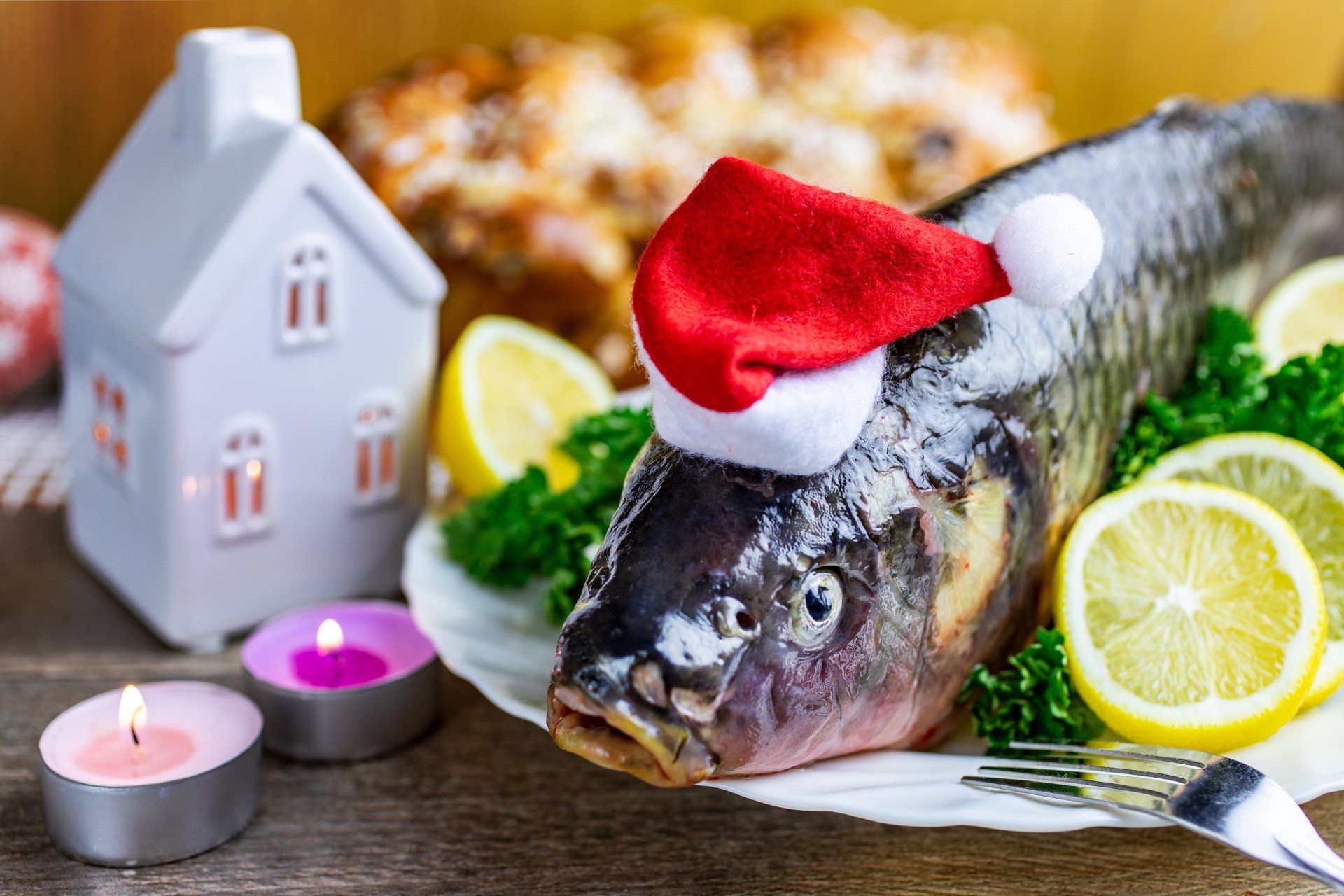
A very festive carp on a plate
What about the carp?
The carp is a reminder of older traditions and the somewhat violent acts in the preparation of food.
It is customary these days to get fresh carp fillets that have been de-boned and skinned for you, but a lot of families still do what my family did when I was younger.
We used to buy a live carp at the market and bring it home to live in a tub for a day or two where it became a new pet for the kids to play with. Then, prior to Christmas, the man of the house killed it with a hammer, gutted and skinned it. A lot of people opt for a chicken schnitzel for dinner nowadays, and I suspect it has less to do with the taste and everything to do with their childhood memories of eating the fish in their tub.
We also eat soup, which is traditionally made from the freshly cut-off fish head and all the fish milt left over.
Why can you see into the future on Christmas Day?
The Czech Christmas is a peaceful time of the year, sprinkled with a little magic. It is believed that you can see into the future on Christmas Day.
Unmarried women throw a shoe over their shoulder and if it lands with its tip pointing to the door, it means they will marry in the New Year.
We also pour small amounts of melted lead to a bowl of water and observe what shape it takes as it cools down because we believe it is a sign of what is to come in the New Year. And we cut apples, only to check if the core forms a perfect star in the cut, meaning good health in the New Year.
One could say we combine many pagan traditions with Christian ones and drown it all in an eggnog or mead or beer. But like any other nation in the world, we mostly eat a lot, drink a lot and spend time with family and friends.
Merry Christmas— or Veselé Vánoce—and I wish you all the best in the New Year, Denisa.
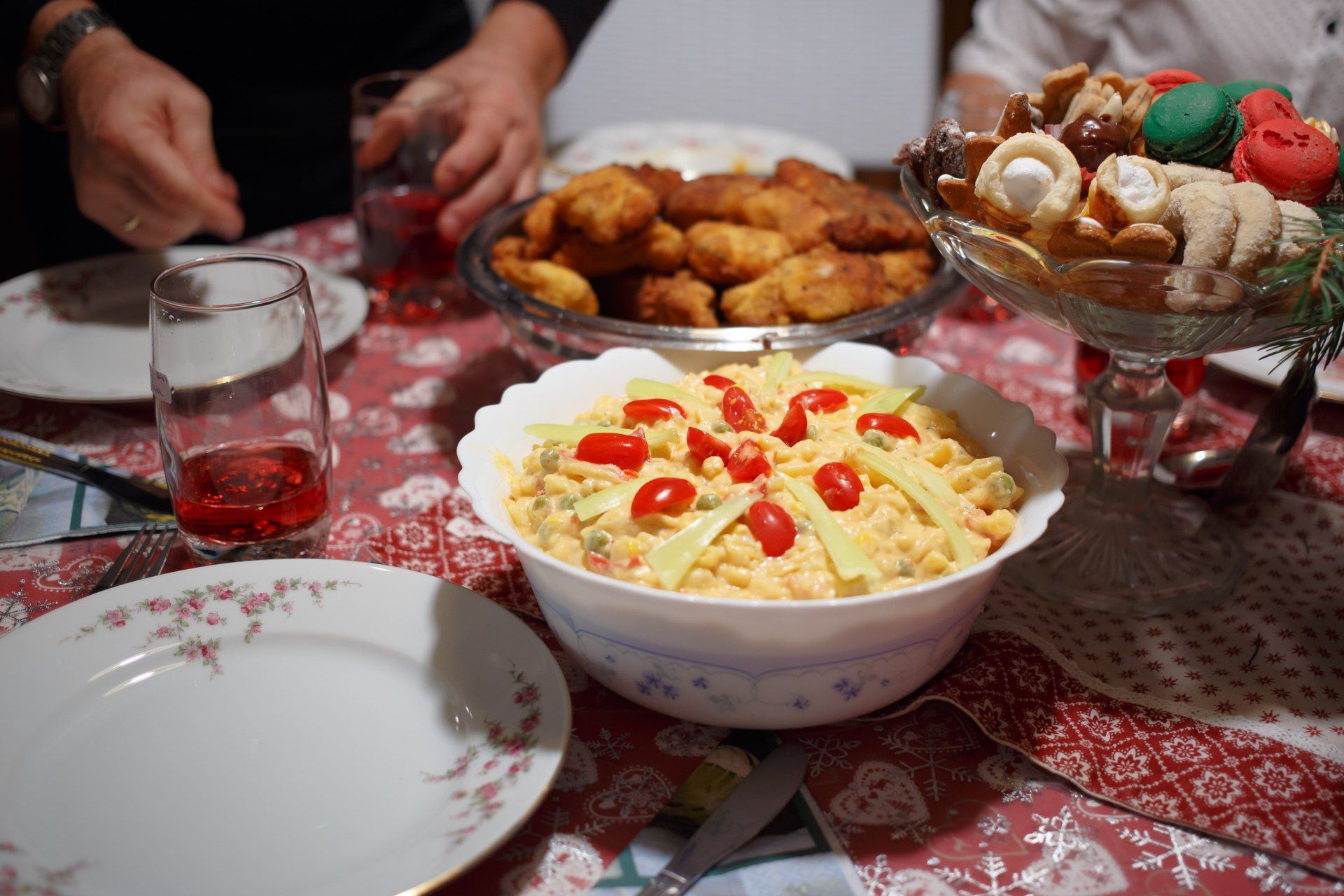
From all of us here at Cambridge Management Consulting, wherever you are, we wish you a very merry Christmas and best wishes for the New Year!!
Contact - Africa
About Us
Cambridge Management Consulting (Cambridge MC) is an international consulting firm that helps companies of all sizes have a better impact on the world. Founded in Cambridge, UK, initially to help the start-up community, Cambridge MC has grown to over 200 consultants working on projects in 24 countries. Our capabilities focus on supporting the private and public sector with their people, process and digital technology challenges.
What makes Cambridge Management Consulting unique is that it doesn’t employ consultants – only senior executives with real industry or government experience and the skills to advise their clients from a place of true credibility. Our team strives to have a highly positive impact on all the organisations they serve. We are confident there is no business or enterprise that we cannot help transform for the better.
Cambridge Management Consulting has offices or legal entities in Cambridge, London, New York, Paris, Dubai, Singapore and Helsinki, with further expansion planned in future.
Find out more about our
telecommunication services and
full list of capabilities
Subscribe to our Newsletter
Blog Subscribe
SHARE CONTENT






